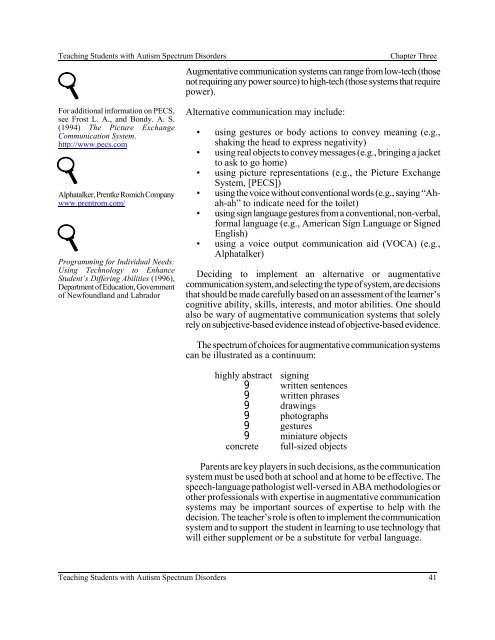Teaching Students with Autism Spectrum Disorders
Teaching Students with Autism Spectrum Disorders
Teaching Students with Autism Spectrum Disorders
Create successful ePaper yourself
Turn your PDF publications into a flip-book with our unique Google optimized e-Paper software.
<strong>Teaching</strong> <strong>Students</strong> <strong>with</strong> <strong>Autism</strong> <strong>Spectrum</strong> <strong>Disorders</strong> Chapter Three<br />
For additional information on PECS,<br />
see Frost L. A., and Bondy. A. S.<br />
(1994) The Picture Exchange<br />
Communication System.<br />
http://www.pecs.com<br />
Alphatalker, Prentke Romich Company<br />
www.prentrom.com/<br />
Programming for Individual Needs:<br />
Using Technology to Enhance<br />
Student’s Differing Abilities (1996),<br />
Department of Education, Government<br />
of Newfoundland and Labrador<br />
Augmentative communication systems can range from low-tech (those<br />
not requiring any power source) to high-tech (those systems that require<br />
power).<br />
Alternative communication may include:<br />
• using gestures or body actions to convey meaning (e.g.,<br />
shaking the head to express negativity)<br />
• using real objects to convey messages (e.g., bringing a jacket<br />
to ask to go home)<br />
• using picture representations (e.g., the Picture Exchange<br />
System, [PECS])<br />
• using the voice <strong>with</strong>out conventional words (e.g., saying “Ahah-ah”<br />
to indicate need for the toilet)<br />
• using sign language gestures from a conventional, non-verbal,<br />
formal language (e.g., American Sign Language or Signed<br />
English)<br />
• using a voice output communication aid (VOCA) (e.g.,<br />
Alphatalker)<br />
Deciding to implement an alternative or augmentative<br />
communication system, and selecting the type of system, are decisions<br />
that should be made carefully based on an assessment of the learner’s<br />
cognitive ability, skills, interests, and motor abilities. One should<br />
also be wary of augmentative communication systems that solely<br />
rely on subjective-based evidence instead of objective-based evidence.<br />
The spectrum of choices for augmentative communication systems<br />
can be illustrated as a continuum:<br />
highly abstract signing<br />
9 written sentences<br />
9 written phrases<br />
9 drawings<br />
9 photographs<br />
9 gestures<br />
9 miniature objects<br />
concrete full-sized objects<br />
Parents are key players in such decisions, as the communication<br />
system must be used both at school and at home to be effective. The<br />
speech-language pathologist well-versed in ABA methodologies or<br />
other professionals <strong>with</strong> expertise in augmentative communication<br />
systems may be important sources of expertise to help <strong>with</strong> the<br />
decision. The teacher’s role is often to implement the communication<br />
system and to support the student in learning to use technology that<br />
will either supplement or be a substitute for verbal language.<br />
<strong>Teaching</strong> <strong>Students</strong> <strong>with</strong> <strong>Autism</strong> <strong>Spectrum</strong> <strong>Disorders</strong> 41

















